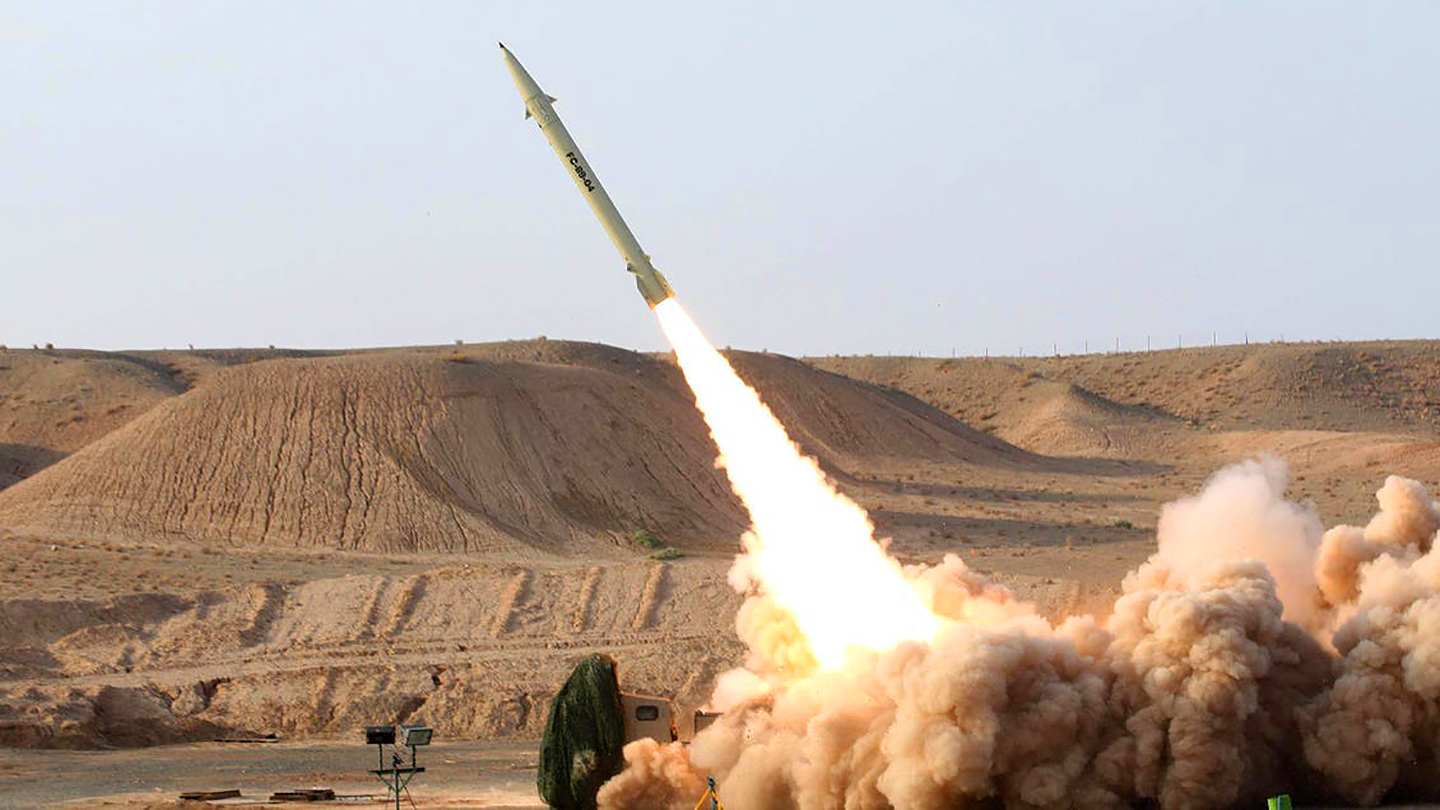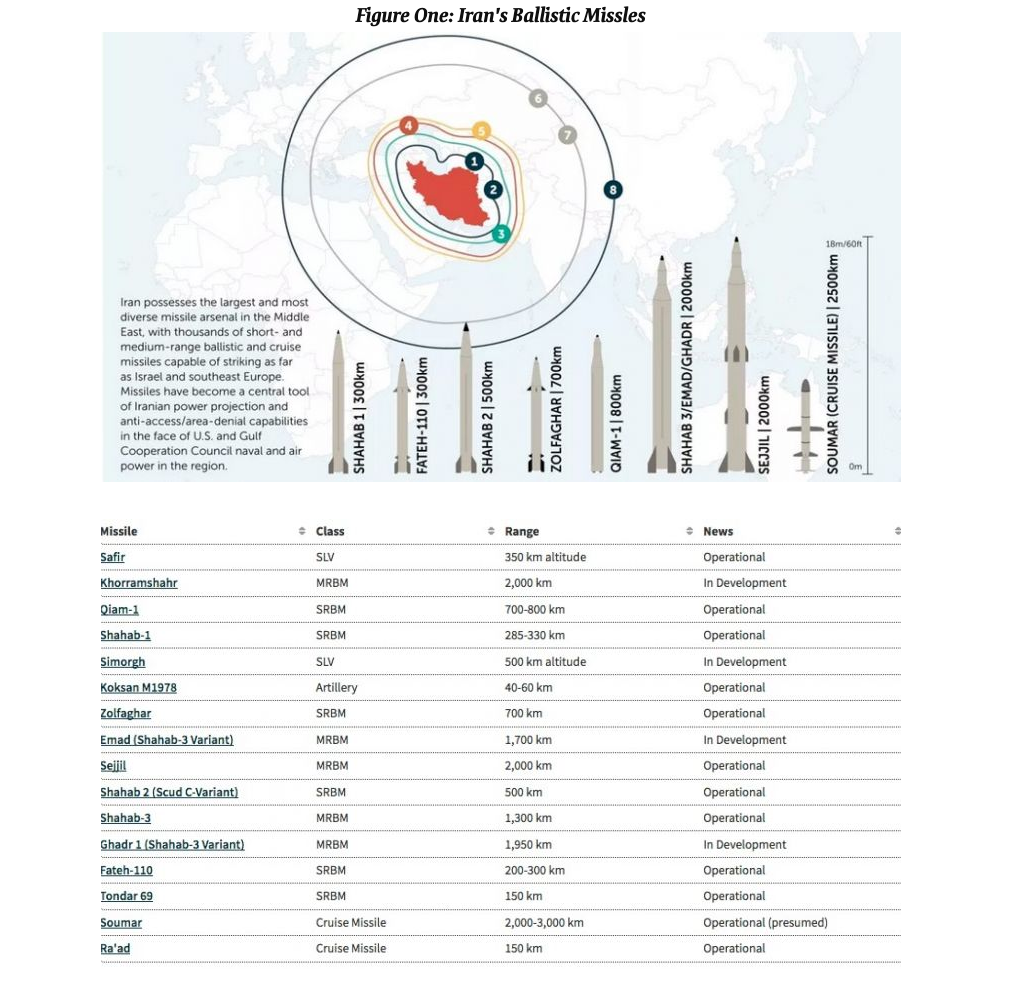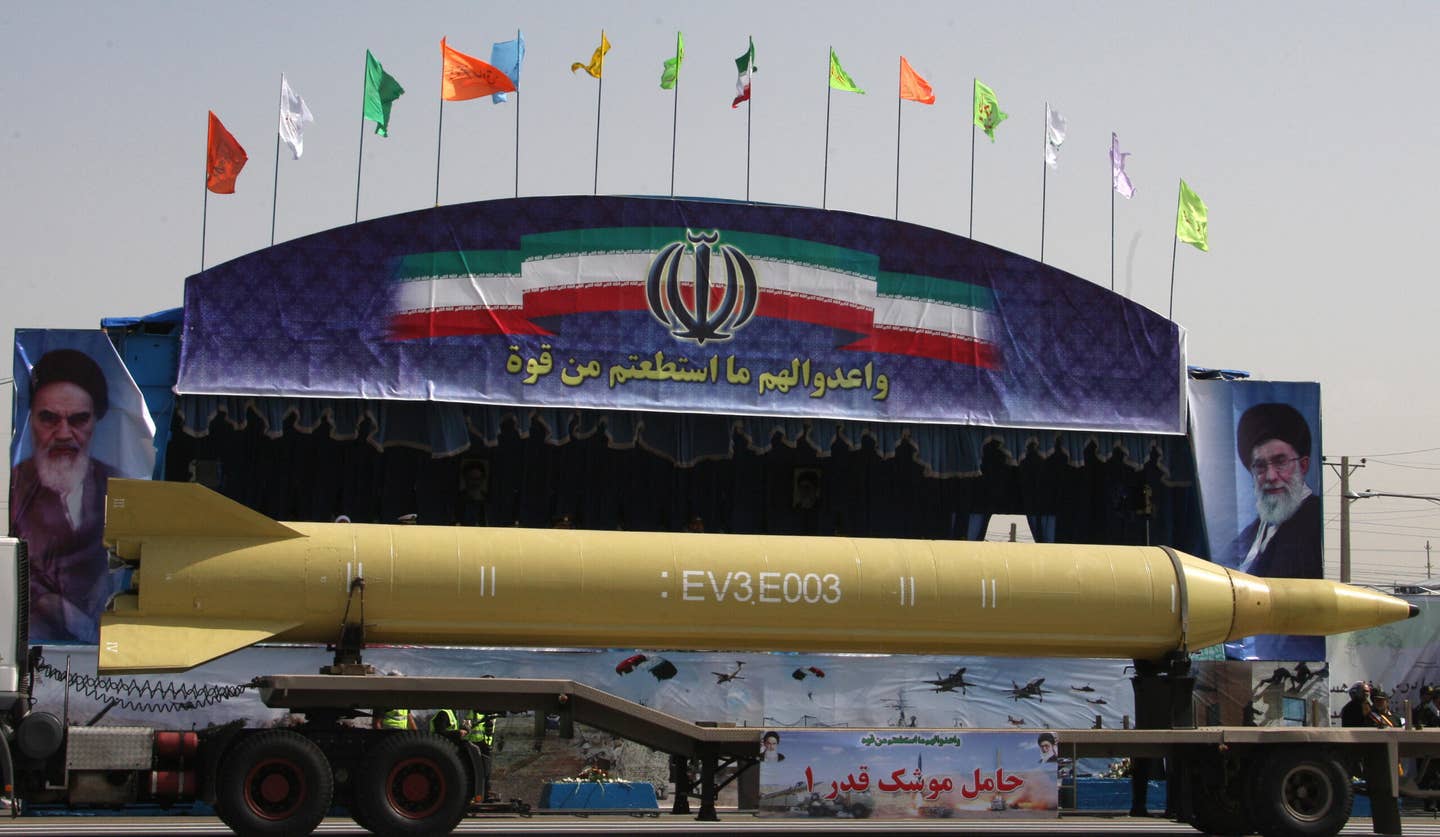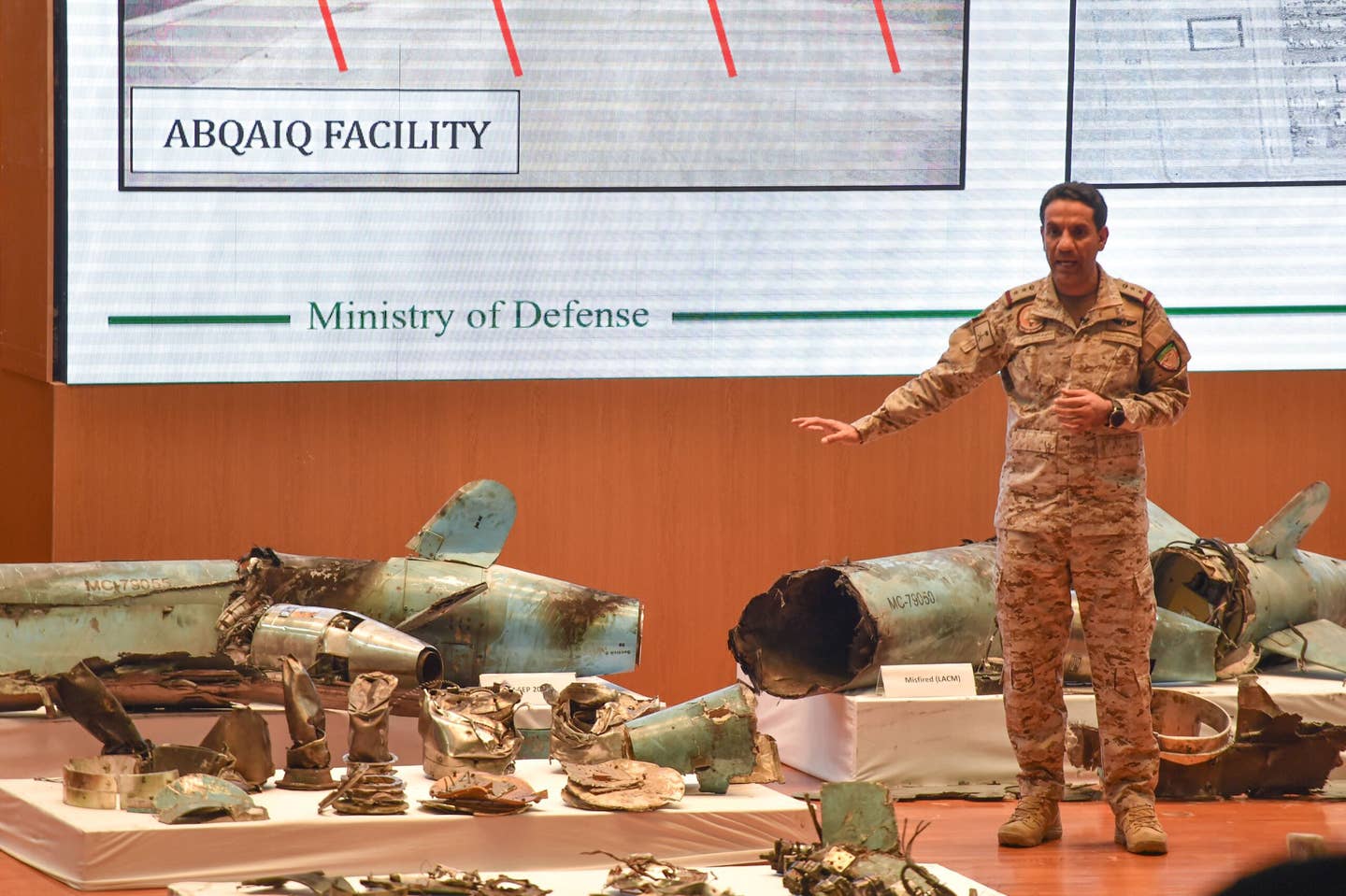Raghfarm007
FULL MEMBER

- Joined
- Mar 18, 2017
- Messages
- 1,187
- Reaction score
- -1
- Country
- Location

Could Long-Range Iranian Missiles Be Next For Russia?
After supplying kamikaze drones for Russia’s war in Ukraine, cash-hungry Iran could restock Moscow’s dwindling long-range missile arsenal.
Could Long-Range Iranian Missiles Be Next For Russia?
After supplying kamikaze drones for Russia’s war in Ukraine, cash-hungry Iran could restock Moscow’s dwindling long-range missile arsenal.BYTHOMAS NEWDICK, TYLER ROGOWAY|PUBLISHED OCT 11, 2022 5:12 PM
THE WAR ZONE

Iranian State Media
SHARE

THOMAS NEWDICKView Thomas Newdick's Articles
CombatAir

TYLER ROGOWAYView Tyler Rogoway's Articles
Aviation_Intel
According to a statement from Ukrainian Air Force spokesperson Yurii Ihnat, Russia launched “over 83 missiles” in yesterday’s attack on Ukraine — as well as 17 Iranian-supplied Shahed-136 ‘kamikaze drones.’ Of those 83 mainly long-range missiles, the air force claimed it shot down 43. While these numbers can’t be independently verified, the missile assault was clearly on a much greater scale than we have otherwise seen in recent months.
With the primary targets being of a civilian nature, including energy infrastructure, that also means fewer missiles of this kind are available to Russia for high-priority military targets, including hardened ones. Meanwhile, there are plenty of reports that suggest that the Kremlin’s stocks of precision-guided standoff missiles may be running low. With limited production capacity and sanctions hampering their direct replacement, and Moscow already being a customer of Tehran's drones, it’s possible we may start to see Iranian-made ballistic missiles employed by Russia in its war in Ukraine.
“We believe that Russia is running short of munitions, Jeremy Fleming, head of the U.K.’s GCHQ intelligence and security organization, told the BBC today. “It’s certainly running short of friends… The word I’ve used is ‘desperate’. We can see that desperation at many levels inside Russian society and inside the Russian military machine,” he added.
Iran could potentially help Russia on both those counts.
The idea of Iran transferring ballistic missiles to Russia is something that was, briefly, raised by Iranian state media over the weekend. In a French-language article, a claim was made that a missile attack on Bohorodychne, in Donetsk Oblast, bore the hallmarks of the Iranian-made Khyber Shikan medium-range ballistic missile (MRBM). There is no evidence of that being the case, let alone of Iranian missiles already being sent to Russia. The article was since heavily edited, with these portions removed, but is now archived. While online, the full article did seem to at least raise the prospect of a missile deal between Moscow and Tehran, even running under the title “After Geran-2/Shahed-136, a place for Khyber Shikan?”
Russian standoff missile status
We have discussed in the past the different types of long-range missiles that Russia has used in its campaign in Ukraine so far. The highest-profile among these are the Kalibr cruise missiles that can be fired from warships and submarines, with a derivative of the same 3M14 land-attack missile also being available for ground launch from the Iskander (known to NATO as the SS-26 Stone) system.
An Iskander system launches a cruise missile as part of a planned exercise earlier this year:
For its part, the ground-based Iskander system can fire this aforementioned cruise missile as well as a number of different quasi-ballistic missiles from the 9M723 Iskander-M series. Using ballistic missiles of any kind offers key advantages to Russia, but stocks of these important weapons are also reportedly running low and there are challenges in replenishing them. They are particularly needed to hit hardened and high-priority military targets, like command and control bunkers.
Ballistic missiles are, by definition, tricky to defend against — considerably harder in some regards than subsonic land-attack cruise missiles. The Iskander ballistic missile also deploys advanced countermeasure decoys during its flight to make interception even harder.
Ukraine, in particular, has very limited anti-ballistic missile capabilities, primarily resting upon a small number of Soviet-era S-300V1 (SA-12 Gladiator/Giant) surface-to-air missile systems. The S-300V1 was never available in significant numbers to Ukraine and there are no surplus systems of this kind that could be supplied by NATO militaries to reinforce Ukrainian defenses.
Kalibr and Iskander missiles are expensive items and, as mentioned above, it’s unclear to what degree Russia is able to produce new rounds to replenish its stocks. It’s likely, too, that diminished access to high-technology components as a result of sanctions is having an effect on its ability to manufacture precision weaponry of this kind.
In general, there is a huge premium placed on standoff weaponry of this kind in Russia as a result of the continued inability of its air forces to secure air superiority over Ukraine. This has meant that fixed-wing tactical aircraft have been generally incapable of striking targets beyond the front lines without putting themselves and their crews at extreme risk. As long as this situation remains, stocks of standoff weapons will continue to be depleted and any replacements will be relatively prized.
The fact that S-300P series surface-to-air missiles are now being used increasingly in a surface-to-surface role may well point to a lack of Kalibr and Iskander rounds. Unconfirmed reports indicate Russia also used S-300Ps in yesterday’s attacks.
As far as Russia’s Long-Range Aviation is concerned, we have reported already the fact that stocks of Kh-555 (AS-22 Kluge) cruise missiles may well have been totally exhausted during the Russian operation in Syria.
So far, at least, all available imagery of air-launched cruise missiles used in Ukraine shows the more modern Kh-101 (AS-23A Kodiak). Writing for The War Zone last month, Russian aerospace expert Piotr Butowski concluded that there were probably fewer than 100 Kh-101 missiles left in stock, with a current production rate not exceeding three to four per month. This also seems to have been evidenced by the reduced use of Kh-101 missiles in Ukraine in recent months, although these weapons appear to have been used again yesterday.
Overall, the situation facing Long-Range Aviation appears to be critical enough for the service to have begun using larger numbers of Cold War-era Kh-22 (AS-4 Kitchen) anti-ship missiles to strike land targets. Airstrikes using Kh-22s (and possibly improved Kh-32s) peaked during the summer, with Ukrainian sources stating that 200 of these missiles were launched in the second half of June alone. Among the targets was the shopping mall in Kremenchuk, Poltava Oblast, which was hit on June 27.
As we have noted in the past, the stocks of Kh-22 missiles remaining from the Soviet era are considerable, and the shelf life of these weapons is coming to an end. This makes it cheaper to fire them into Ukraine than to dispose of them — although their accuracy is strictly limited, especially when compared with modern land attack cruise or ballistic missiles.
From drones to missiles
At the start of the Russian invasion on February 24 this year, it might have seemed far-fetched for Moscow to call upon Tehran to provide it with weaponry, especially for standoff attacks on ground targets — exactly the kind of mission that Russia, on paper, at least, should have covered by plenty of different platforms.
However, Iran supplying Russia with “hundreds” of drones, including Shahed-136 ‘kamikaze drones’ and the larger Mohajer-6, demonstrates that Moscow is willing to (or has been forced to) turn to non-traditional channels to quickly get its hands on certain capabilities it desperately needs for its faltering operations in Ukraine.
Ballistic missiles would certainly seem to fit the same criteria, and Iran has them in spades.
Tehran’s development of increasingly sophisticated and longer-range ballistic missiles is by now a familiar and important factor on wider geopolitical issues in the Middle East. Together with cruise missiles and UAVs, Iran’s ballistic missiles are intended to have a deterrent effect but, also, and importantly for Russia, they have been used in action by Iran and its proxies.
The potential of Iranian-made ballistic missiles to cause significant destruction is in little doubt, with multiple instances of them having been employed in combat. In the last couple of years, such incidents have included the January 2020 attack against Al Asad Air Base in Iraq, which made use of a Qiam series short-range ballistic missile (SRBM), and the March 2022 attack on Erbil in Iraq, which used Fateh-110 SRBMs. These weapons hit very hard with an impressive degree of accuracy.

A U.S. service member walks through a damaged portion of Al Asad Air Base in Iraq in the aftermath of Iranian ballistic missile strikes on January 8, 2020. Qassim Abdul-Zahra/AP
Iran’s ballistic missile systems have also been characterized by their proliferation — another factor that has a significant bearing on stability in the Middle East. According to Western estimates, there are at least 20 different Iranian ballistic missile designs, and more still if different sub-variants are included. It also means there is a wide assortment of different missiles that Russia could choose to buy and, for many of the relevant types, significant stocks that would enable rapid transfer.

CSIS.org
Since Iranian ballistic missiles have traditionally been tailored for regional conflicts, they also fall within the kind of range categories that would be useful to the Russian Armed Forces during their war in Ukraine.
The Qiam-1 SRBM, for example, has a reported range of 500 miles, which would allow Russia to strike targets across the entirety of Ukraine. Were the same missiles to be deployed on Belarusian territory, that would become even easier.
That Iran is willing to supply the Qiam-1 to foreign clients is demonstrated by the fact that it has been used by Yemeni Houthi rebels against Saudi targets. Later versions of the Qiam series also feature a maneuverable reentry vehicle, or MaRV, which provides improved accuracy against high-value targets and complicates interception. However, the kind of bombardment of Ukrainian cities that was witnessed yesterday suggests that Russia may also be happy to use less accurate missiles in ‘vengeance’ strikes intended to grind down the resolve of the Ukrainian population.

January 7, 2022, and Islamic Revolutionary Guard Corp military personnel talk as a Qiam SRBM is displayed in a military exhibition to mark the anniversary of the Iran missile attack on Al-Assad Air Base in Iraq. Photo by Morteza Nikoubazl/NurPhoto via Getty Images
Other Iranian missiles, like the Ghadr, which was derived from the Shahab-3 MRBM would offer even greater range — reportedly up to 1,200 miles. This would provide Russia with the advantage of being able to base such weapons much further from Ukraine’s borders. On the other hand, the inherent mobility of the various road-mobile types of Iranian ballistic missiles would make them a very difficult target for Ukraine, which has very limited standoff weapons capabilities, anyway.

A truck carries a Ghadr-1 missile during an annual military parade in Tehran on September 22, 2009. ATTA KENARE/AFP via Getty Images
One disadvantage of certain longer-ranged Iranian missiles, including the Qiam-1 and the Ghadr, is the fact they still rely on liquid-propellant systems. These are not only more hazardous to use but mean that the system takes considerably longer to bring into action. That being said, Russia doesn’t require rapid-response weapons for many of its targets and there remains the option of procuring shorter-range missiles with solid propellants that could similarly provide much-needed standoff weaponry.
The Fateh family, for example, are road-mobile, solid-fuel SRBMs some of which reportedly feature terminal guidance that also allows more accurate strikes against certain targets. The Fateh-110, which has been proven operationally and put into large-scale production would be a very likely candidate. It packs roughly a 185-mile range, making it efficient for many targets in Ukraine. At the upper end of this series is the two-stage Qasem which has a claimed range of 870 miles, putting it in the MRBM bracket.
Even older and less complex and accurate Shahab ballistic missiles could be of interest considering Russia doesn’t seem to care about avoiding civilian casualties for some of its target packages.
In addition to ballistic missiles, Iran could potentially also provide Russia with other standoff weapons. In addition to more and different types of UAVs, which you can read about in-depth here, Iran produces long-range cruise missiles, including some that are almost certainly derived from original Soviet technology.
Notable among these is the Quds-1, attributed with a range of over 430 miles and proven in combat, during the remarkable attack on the Saudi Aramco oilfield in September 2019. In that case, the operation was claimed to have been prosecuted by Houthi rebels but is widely thought to have been planned and carried out by Iran.

A Saudi defense ministry spokesman displays pieces of what he said were Iranian cruise missiles and drones recovered from the attack site that targeted the Saudi Aramco facilities, during a press conference in Riyadh in September 2019. Photo by FAYEZ NURELDINE/AFP via Getty Images
Iran has a diverse array of cruise missile capabilities of varying ranges and warhead classes, some far less advanced and proven than others. But regardless, Tehran could supply Russia with these systems, and even if many are shot down, they would also work to deplete Ukraine’s air defenses.

Iran’s Hoveyzeh cruise missile that is loosely based on the Russian Kh-55. Russian State Media
Iranian surface-to-surface missiles often use transporter-erector-launchers (TELs) based on commercial truck chassis, which are straightforward to maintain and operate and would not have to be deeply integrated with Russian vehicles.
Russia and Iran: Brothers in arms?
For Iran, which has long been in the international wilderness and under immense sanctions, primarily due to its nuclear program and malign activities, including supplying arms and other support to militant proxy forces, an injection of cash from Moscow would also be very welcome. A sale of long-range missiles would build upon the previous drone transfer and add a very lucrative client to Tehran’s limited weapons export portfolio. Getting the weapons to Russia wouldn’t be a big challenge, with the possibility to transport them by ship over the Caspian Sea. Longer-term, local production in Russia could be an option, as well, as has also been suggested for the Shahed-136 drone. This could also involve Iran sending the components to Russia for local assembly.
At this point, the delivery of Iranian ballistic missiles (or cruise missiles) to Russia remains speculative. On many levels, however, it would appear to offer benefits to Moscow, which has few alternative sources of weaponry of this kind.
For Tehran, beyond the much-needed revenue, such a sale would provide another chance to prove some of its increasingly advanced missile technologies in combat. Iran has established sanctions-insulated production lines for a variety of long-range missiles and many of the types would be available almost immediately, as well as being potentially easier to restock in the immediate future. A similar kind of thinking could have underpinned Russia’s reported efforts to obtain North Korean ammunition, too. North Korea could ultimately also be a source of standoff missiles, although Iran remains a far better option for these types of more advanced weapons.
Whatever happens, Russia has shown again that it’s willing to launch long-range strikes against both Ukrainian cities and critical (non-military or dual-use) infrastructure. How long these sorts of campaigns could be sustained will depend not only on its stocks of land-attack missiles (and the possibility of backfilling them) but also on the continued development of Ukraine’s air defenses.
So far, the supply of high-end Western ground-based air defense systems to Ukraine has proceeded only very slowly, while the frequently requested delivery of high-end Western fighter jets has failed to materialize.
However, Ukrainian President Volodymyr Zelensky said yesterday on his Telegram channel that he had “a productive conversation” with his U.S. counterpart Joe Biden, in which “the main topic of discussion was air defense. Currently, this is the number one priority in our defense cooperation.” But the systems that are set to arrive in Ukraine fairly soon are not designed to counter ballistic missiles.
Meanwhile, in an official White House statement, Biden talked about providing Ukraine with more “advanced air defense systems,” although no further details were provided. Nevertheless, it has to be remembered that improved air defenses will not stop all the attacks, especially if Russia does find a new supply of standoff weaponry and the only system the U.S. has that would suit ballistic missile and area air defense is the Patriot system, which has not been offered to Ukraine.
With Russian stockpiles running low, it is hoped that attacks like the ones this week on population centers in Ukraine will be increasingly hard to pull off for Moscow, but if Iran ends up striking a deal with its Russian cohorts, it could complicate the situation dramatically and it could put everything from Ukrainian cities to military bunkers in greater peril.
Contact the author: [email protected]








